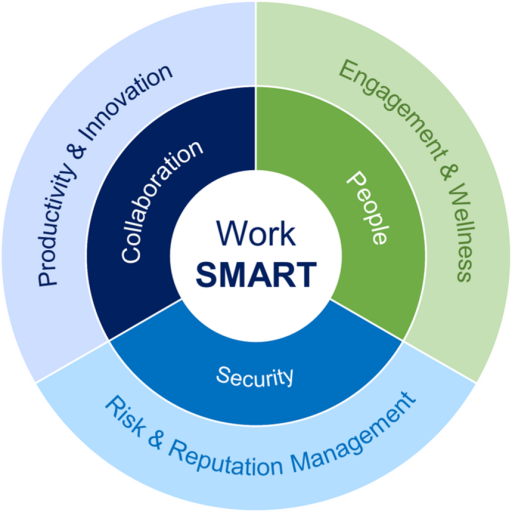Discussion about new ways of working, brought about by COVID, has pretty much been done to death. We get it; and it’s happening. Ironically, it is being driven my management and staff because the flexible mix of working from the office and working from home is increasing productivity for the business and flexibility for staff.
So, the question is, what are the considerations for ‘doing it well’ and how can you make it sustainable?
The three pillars model – or we call it ‘Work Smart’ – provides a framework for ensuring success in a post-COVID world.
1. Collaboration
With staff predominantly working from home, empowering them with the right collaboration tools is critical. Video first collaboration is preferable because it optimises the personal engagement which suffers when people can’t meet and mix in the office. Instant messaging, the ability to initiate video meetings with a single click and ‘spaces’ for collaborating and managing people, projects and issues are important features of an effective collaboration platform.
Having the right collaboration platform optimises staff productivity and drives innovation and is even more critical where people are largely working in isolation.
2. Security
Because of the rush and necessity to work from home, IT security considerations initially took a back seat, but now organisations are realising that there are many risks with staff working from home.
Managing security isn’t solved solely by a technology solution. People and their behaviours are a critical piece of the security puzzle and they need to be supported by training and backend processes.
From a technology perspective, the three key vulnerabilities to be addressed are email, web and endpoints (computers, laptops, phones).
Security solutions have become more sophisticated in recent years and have moved beyond the simple firewall concept. Now, security is intelligent and proactive, and emails and web addresses can be checked before they cause problems. New, smart security apps are constantly checking endpoints (hardware) for vulnerability. For example, an alert is triggered when an iPhone has an out of date operating system because this means potential vulnerability. Organisations are now creating security ecosystems with a single dashboard to address the different types of threats and different devices on the network.
Unfortunately, security is often seen as a nice to have, but the risks of intrusion are significant.
For an organisation, there can be loss of IP (intellectual property), data can be locked up by ransomware, the business can be interrupted for hours or days which can be extremely costly and applications/systems can be breached leading to a direct loss of funds.
But the need for robust security is also being driven by customers. They want to deal with an organisation they trust because they are giving up important personal data and access to financial records.
Managing security is all about risk and reputation management.
3. People
Yep, that’s right, embedded in the mantra of the management consultants, but often relegated to a secondary consideration is ‘People’. Getting this pillar right is what will make your new way of working successful and sustainable in the long term.
The risk is that staff lose their connection with the business, and therefore their loyalty. There is also the issue that ‘functionally’ work can be done very efficiently from home, but what’s missing is the informal communications, incidental creativity and the ability to have frank, direct and sometimes uncomfortable conversations which are better done face to face.
Video meetings are typically more formal than face to face meetings, so people will need to start feeling more comfortable being vulnerable and ‘real’ on camera so engagement can be authentic and effective.
How can you differentiate your organisation so you maximise staff retention? What value-added experiences can you offer your staff so they don’t feel like they are a robot or simply contractors? How can you balance productivity with innovation?
In the long term, managing people is the most important and the pillar and it requires the most attention. During COVID, and as we emerge, working from home has been somewhat of a novelty, but organisations need to develop a long term strategy for staff engagement that deals with the new working environment. Each organisation will have its own approach, and there is a lot of experimenting being done now with things like drinks over video and specific days when all the team must be in the office so relationships can be maintained and informal communication encouraged. But a token and tactical approach won’t work in the long run.
Aside from tactical engagement activities, the glue that will bind remotely working organisations together is ‘purpose’. Why are we working together? What’s our strategy? What value are we creating for what customers? And who are we directly competing against? This requirement puts more pressure on the business to have clarity in its purpose and have clear, effective communication and messaging.
The other, and very important issue is staff well-being. A lot of simple – and we’re now discovering, important – things have been taken away by COVID. Commuting, while it’s consumes time, is important for winding down and thinking. Physical exercise is now more difficult and social connection has been greatly reduced.
Employers will need to be more conscious of employee well-being in an environment where it’s more difficult to ‘eyeball’ people and see how they are really feeling.
Also impacting well-being is the employee’s physical work environment in terms of ergonomics, ventilation, temperature and comfort. Not actively managing these factors is a risk for the business and poor management could result in workers compensation claims and legal issues.
